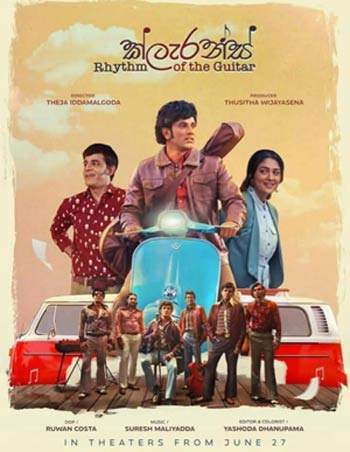A cinematic journey back to the heyday of Sinhala pop
View(s): Friday was always a very special day for us as school kids, the weekend promising either street cricket or watching the game at the SSC with father, but more importantly tuning our Grundig valve radio to the Sinhala commercial service at 2 p.m. sharp upon reaching home. So from the school bus, we sprinted home from the bus-stop so as not to miss a second of the much-awaited programme. 1970 hadn’t dawned in Sri Lanka yet!
Friday was always a very special day for us as school kids, the weekend promising either street cricket or watching the game at the SSC with father, but more importantly tuning our Grundig valve radio to the Sinhala commercial service at 2 p.m. sharp upon reaching home. So from the school bus, we sprinted home from the bus-stop so as not to miss a second of the much-awaited programme. 1970 hadn’t dawned in Sri Lanka yet!
Regrettably, the SLBC Sinhala service only allocated a paltry 15 minutes a week for our favourite genre of Sinhala group songs of which we children had already become diehard fans. We had listened to Latino- sounds of Los Caberlos, Los Flamingoes and Los Muchajoes of the mid-60s but somehow they were not our very own. We venerated the golden voice of Neville Fernando but the orchestrated Latino band sounds were not what we were after. We had also begun appreciating the Beatles, Joan Baez, Bob Dylan and Paul Simon whose simplicity in arrangements we came to admire.
In this wake, the mellow sounds of Moonstones reached our ears for the first time in 1969. And didn’t we fall in love instantly.
It took a long time to learn about the band members. But, as EP records reached Children’s Bookshop in Fort and music gossip picked up, the band members became household names. Such was the sudden storm. Not everyone though owned a turntable then and we were envious of classmates who boasted about listening to The Moonstones, day in and day out, at home.
Later we got to know that the melodies and most of the lyrics were the work of that outstanding musician Clarence Wijewardena and that most vocals were by Annesley Malewana. News spread that they were from Ratnapura. The gang also had Monty, Mangala, Vijith and Mike, the latter joining the band later. I remember attending a couple of family weddings in Colombo at which The Moonstones performed because of their growing popularity at the time.
Very quickly, as quickly as their second EP was launched, they had found the matching dulcet voice of Indrani Perera as the female vocalist to support Annesley. The duets with Annesley became so touching, young lovers couldn’t be separated from them. Yet, we were starved of their music on the SLBC; the only channel available for us to listen to Sinhala music and it was the mighty Corea clan, Sangabo, Vernon and Vijaya, who having influence in the English music stream of the SLBC, gave fans like us a chance on Saturday evening on their radio show. It was they who convinced businessman Gerald Wickramasooriya of ‘Sooriya’ fame to invest in the hugely talented group.
By then we had come to realize it was Clarence’s magical melodies and his simple guitar-based arrangements that defined the Moonstones though the youthful voices of Annesley and Indrani added an unimaginable flavour to their hits.
It was to this fount of my memories that ‘Clarence: Rhythm of the Guitar’ sailed in – in 2025.
The cinema was full with people of all walks of life – mostly senior citizens – and no doubt, they all wanted to reminisce the birth of Sinhala pop culture.
The film had me spellbound. Yes, there is no remarkable storyline but the script had to find something solid to weave the immortal melodies around, and they created a juicy love story no one had heard of. The eye-catching cinematography was a strong pillar to entwine the recreated original songs around. The experienced Ruwan Costa was in charge of photography, and veteran musician Suresh Maliyadde entrusted the crucial task of fitting in the music score. Suresh had used strings and the piano very effectively to say nothing of the haunting saxophone. The music adorned by additional guitar notes than what Clarence’s originals had, not only made the songs brighter but more meaningful. The high-tech stereo sound quality added much value to the gems evoking heartfelt emotions of a bygone era.
The excellent recreation of the late ’60s and early ’70s in the sets, by no means an easy task, left me truly nostalgic for the familiar landscapes of our childhood.
The acting of Saranga Disasekara and Dinakshi Priyasad was the main driving force of the film, with Nihari Perera as Sheila giving a splendid performance showing signs of an upcoming star. The title role of Clarence was well played by the handsome curly haired youngster Damith Wijayathunga, though at times overshadowed by Saranga. Srimal Wedisinghe as Mr. Wallace added a lot of depth reminding one of Tony Ranasinghe in later years. Ramya, superbly played by Ishanka De Costa brought in the much-required mystery to the script. Had she been ‘Ramani’, it would have fit in better with the beautiful hit song Moonstones had in their second EP but ‘Ramya’ was known much later in the mid-70s with the Super Golden Chimes by which time Clarence had moved to Colombo.
There were hardly any downsides to the film save missing the mellifluous voice of the ‘guitar man’ Clarence in the recreations.
The film is a fine tribute to the brilliance of Clarence Wijewardena and the legacy he left for future generations enjoying the Sinhala pop music culture. The movie has left enough room in the Clarence canon for a sequence spanning the mid-70s to late ’80s when Clarence churned out everlasting melodies not only as a solo artist but for other stars like Milton Mallawarachchi, Priya Suriyasena, T.M. Jayaratne and even H.R. Jothipala. It was the era when records gave way to cassettes.
It is a pity that director Theja Iddamalgoda is not around to see the film he would have cherished so much but he, no doubt, would have been congratulated by Clarence on ‘a job well done’ upon meeting in the distant clouds.
-Sasanka Nanayakkara
Searching for an ideal partner? Find your soul mate on Hitad.lk, Sri Lanka's favourite marriage proposals page. With Hitad.lk matrimonial advertisements you have access to thousands of ads from potential suitors who are looking for someone just like you.


